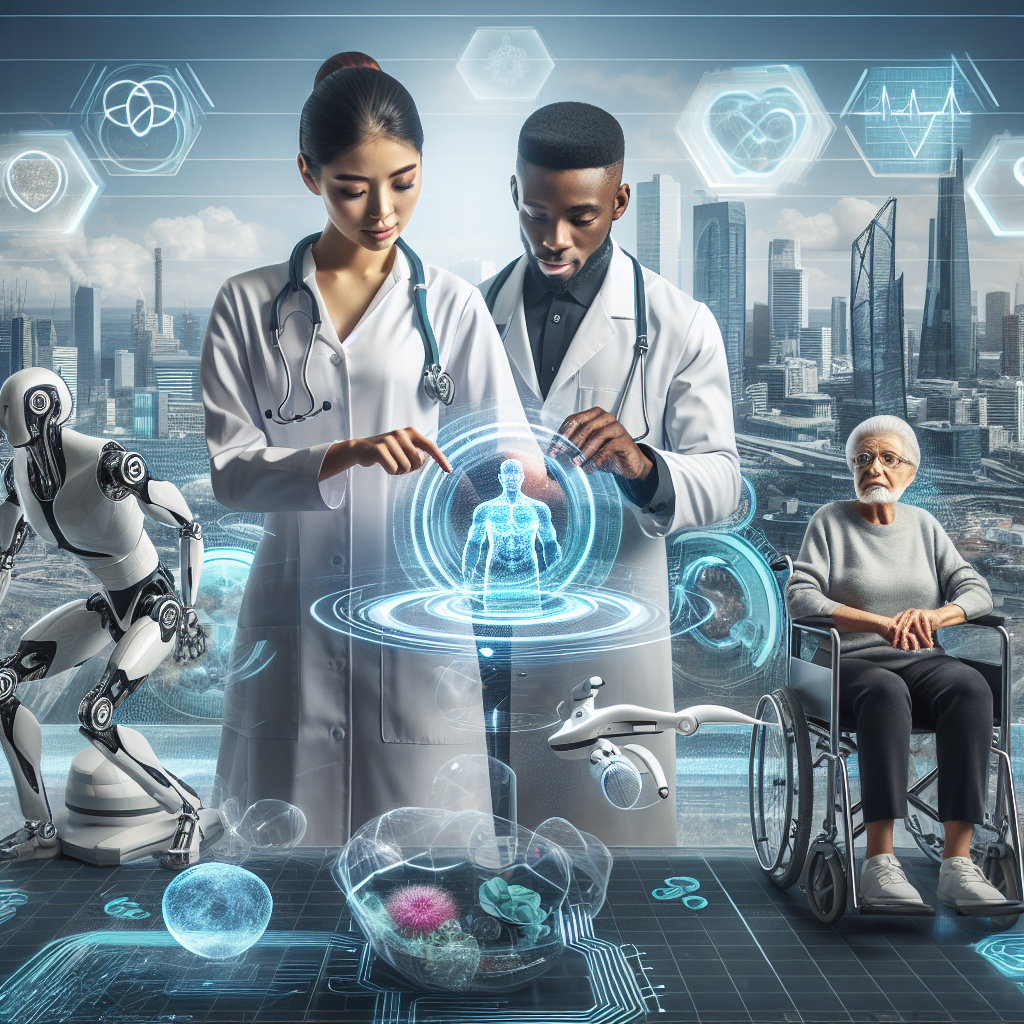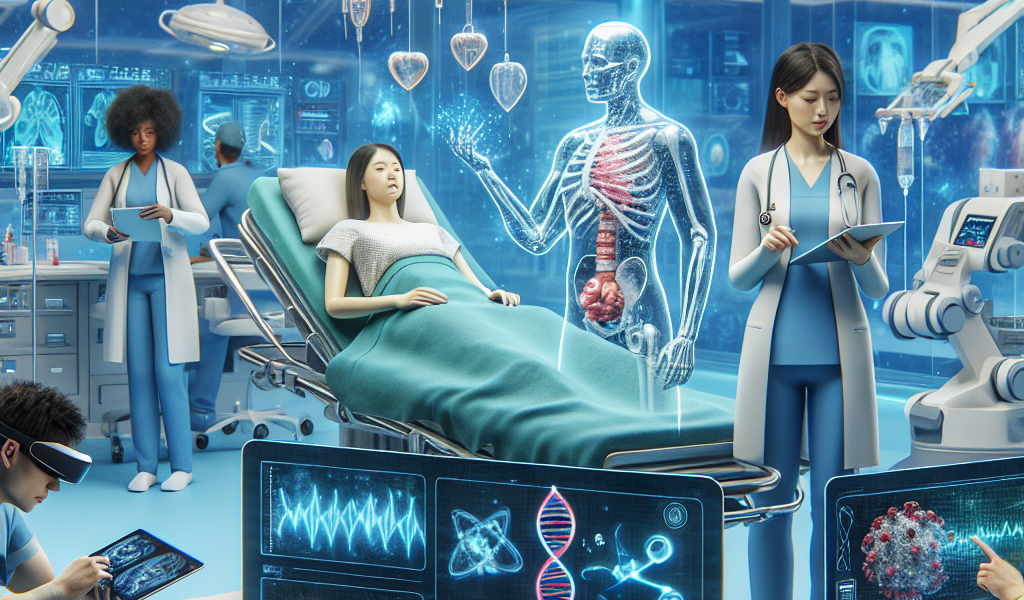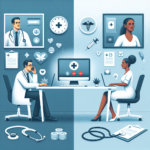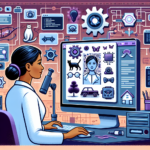-
Table of Contents
“Revolutionizing Wellness: The Digital Transformation of Healthcare”
Introduction

The rapid advancement of technology is revolutionizing the healthcare industry, transforming how medical services are delivered, managed, and experienced. From artificial intelligence and machine learning to telemedicine and wearable devices, innovative technologies are enhancing diagnostic accuracy, personalizing treatment plans, and improving patient outcomes. These technological advancements are not only making healthcare more efficient and accessible but are also paving the way for groundbreaking research and development. As we move forward, the integration of cutting-edge tech in healthcare promises to address some of the most pressing challenges in the field, ultimately leading to a more effective, patient-centered healthcare system.
Artificial Intelligence in Medical Diagnostics
Artificial intelligence (AI) is revolutionizing various sectors, and healthcare is no exception. The integration of AI in medical diagnostics is not just a technological advancement; it is a transformative force that promises to enhance the accuracy, efficiency, and accessibility of healthcare services. As we delve into this topic, it becomes evident that AI’s role in medical diagnostics is multifaceted, offering a range of benefits that could potentially save lives and improve patient outcomes.
To begin with, AI algorithms have demonstrated remarkable proficiency in analyzing medical images. Radiology, a field heavily reliant on imaging, has seen significant improvements due to AI. For instance, AI systems can now detect anomalies in X-rays, MRIs, and CT scans with a level of precision that rivals, and sometimes surpasses, human radiologists. This capability is particularly crucial in early detection of diseases such as cancer, where early intervention can make a substantial difference in patient prognosis. By identifying minute changes that might be overlooked by the human eye, AI ensures that patients receive timely and accurate diagnoses.
Moreover, AI’s potential extends beyond imaging. In pathology, AI-powered tools are being developed to analyze tissue samples and identify patterns indicative of various diseases. These tools can process vast amounts of data quickly, providing pathologists with valuable insights that aid in making more informed decisions. This not only speeds up the diagnostic process but also reduces the likelihood of human error, thereby enhancing the overall quality of care.
Transitioning to another critical aspect, AI is also making strides in predictive analytics. By analyzing electronic health records (EHRs), AI can identify trends and predict potential health issues before they become critical. For example, AI algorithms can flag patients at high risk of developing conditions such as diabetes or heart disease, enabling healthcare providers to implement preventive measures. This proactive approach not only improves patient outcomes but also alleviates the burden on healthcare systems by reducing the incidence of severe, costly medical conditions.
Furthermore, AI’s role in diagnostics is not limited to traditional healthcare settings. Telemedicine, which has gained prominence especially during the COVID-19 pandemic, benefits immensely from AI. Virtual consultations augmented with AI diagnostic tools allow healthcare providers to assess patients remotely with a high degree of accuracy. This is particularly beneficial for individuals in remote or underserved areas who might otherwise have limited access to medical expertise. By bridging the gap between patients and healthcare providers, AI is democratizing access to quality healthcare.
However, the integration of AI in medical diagnostics is not without challenges. Concerns about data privacy, the need for extensive training datasets, and the potential for algorithmic bias are significant issues that need to be addressed. Ensuring that AI systems are transparent and that their decision-making processes can be understood and trusted by both healthcare providers and patients is crucial. Additionally, the collaboration between AI developers and medical professionals is essential to create tools that are not only technologically advanced but also clinically relevant and user-friendly.
In conclusion, the advent of AI in medical diagnostics heralds a new era in healthcare. Its ability to enhance diagnostic accuracy, speed, and accessibility holds immense promise for improving patient care. While challenges remain, the potential benefits far outweigh the hurdles, making it imperative for stakeholders to work together to harness the full potential of AI. As we continue to explore and refine these technologies, the future of healthcare looks increasingly bright, with AI playing a pivotal role in shaping a healthier world.
Telemedicine and Remote Patient Monitoring
In recent years, the healthcare landscape has undergone a significant transformation, largely driven by advancements in technology. Among the most impactful innovations are telemedicine and remote patient monitoring, which have revolutionized the way healthcare is delivered and received. These technologies have not only made healthcare more accessible but have also provided a lifeline for patients who might otherwise struggle to receive timely medical attention.
Telemedicine, the practice of providing medical care remotely, has seen a dramatic rise, particularly in the wake of the COVID-19 pandemic. This surge can be attributed to the necessity of minimizing physical contact to curb the spread of the virus. However, the benefits of telemedicine extend far beyond the pandemic. For many patients, especially those in rural or underserved areas, telemedicine offers a convenient and efficient way to consult with healthcare providers without the need for long and often arduous travel. This is particularly beneficial for individuals with chronic conditions who require regular check-ups and monitoring.
Moreover, telemedicine has proven to be a game-changer for mental health services. The stigma associated with seeking mental health care can be a significant barrier for many individuals. Telemedicine provides a level of anonymity and comfort that encourages more people to seek the help they need. Additionally, it allows mental health professionals to reach a broader audience, including those who might not have access to such services locally.
Transitioning to remote patient monitoring, this technology has also made significant strides in improving patient outcomes. Remote patient monitoring involves the use of digital devices to collect and transmit health data from patients to healthcare providers in real-time. This continuous flow of information enables healthcare providers to make more informed decisions and intervene promptly when necessary. For instance, patients with conditions such as diabetes, hypertension, or heart disease can have their vital signs monitored continuously, allowing for early detection of potential issues and timely adjustments to their treatment plans.
Furthermore, remote patient monitoring can significantly reduce hospital readmissions, which are not only costly but also stressful for patients. By keeping a close watch on patients’ health status from the comfort of their homes, healthcare providers can address potential problems before they escalate, thereby improving the overall quality of care. This is particularly important for elderly patients or those with mobility issues, who may find frequent hospital visits challenging.
The integration of telemedicine and remote patient monitoring into the healthcare system also has the potential to alleviate the burden on healthcare facilities. By reducing the number of in-person visits and hospital admissions, these technologies can help free up resources and allow healthcare providers to focus on patients who require more intensive care. This, in turn, can lead to more efficient and effective healthcare delivery.
However, it is essential to acknowledge the challenges that come with the adoption of these technologies. Issues such as data privacy, the digital divide, and the need for robust internet infrastructure must be addressed to ensure that the benefits of telemedicine and remote patient monitoring are accessible to all. Additionally, healthcare providers must be adequately trained to use these technologies effectively and to interpret the data accurately.
In conclusion, telemedicine and remote patient monitoring are reshaping the future of healthcare by making it more accessible, efficient, and patient-centered. While there are challenges to overcome, the potential benefits of these technologies are immense. As we continue to navigate the evolving healthcare landscape, it is crucial to embrace these innovations and work towards a more inclusive and effective healthcare system for all.
Wearable Technology and Health Data Analytics
In recent years, the intersection of wearable technology and health data analytics has revolutionized the healthcare landscape, offering unprecedented opportunities for both patients and medical professionals. As these innovations continue to evolve, they promise to transform how we monitor, manage, and understand our health, ultimately leading to more personalized and effective care.
Wearable technology, such as smartwatches and fitness trackers, has become increasingly popular among consumers. These devices, equipped with sensors that monitor various physiological parameters, provide real-time data on heart rate, physical activity, sleep patterns, and more. This continuous stream of information empowers individuals to take a proactive role in their health, making informed decisions about their lifestyle and well-being. For instance, a person who notices irregularities in their heart rate can seek medical advice before a minor issue escalates into a serious condition.
Simultaneously, health data analytics plays a crucial role in interpreting the vast amounts of data generated by wearable devices. Advanced algorithms and machine learning techniques analyze this data to identify patterns and trends that might not be immediately apparent to the human eye. This analytical power enables healthcare providers to offer more accurate diagnoses and personalized treatment plans. For example, by analyzing data from a patient’s wearable device, a doctor can detect early signs of chronic conditions such as diabetes or hypertension, allowing for timely intervention and better management of the disease.
Moreover, the integration of wearable technology and health data analytics extends beyond individual care. On a larger scale, aggregated data from millions of users can provide valuable insights into public health trends and potential outbreaks. During the COVID-19 pandemic, for instance, data from wearable devices helped track the spread of the virus and monitor the health of those affected. This real-time information was crucial for public health officials in making informed decisions about containment measures and resource allocation.
However, the rise of wearable technology and health data analytics also raises important ethical and privacy concerns. The collection and analysis of personal health data necessitate stringent measures to protect individuals’ privacy and ensure data security. Companies developing these technologies must prioritize transparency and consent, allowing users to understand how their data is being used and giving them control over their information. Additionally, regulatory frameworks need to evolve to address the unique challenges posed by these innovations, ensuring that the benefits of wearable technology and health data analytics are realized without compromising individual rights.
Despite these challenges, the potential benefits of wearable technology and health data analytics are immense. By providing continuous, real-time health monitoring, these innovations can lead to earlier detection of diseases, more personalized treatment plans, and improved overall health outcomes. Furthermore, the ability to analyze large datasets can drive advancements in medical research, leading to new discoveries and more effective therapies.
As we look to the future, it is clear that wearable technology and health data analytics will play an increasingly important role in healthcare. By embracing these innovations and addressing the associated challenges, we can create a more proactive, personalized, and efficient healthcare system. This transformation holds the promise of not only improving individual health but also enhancing public health on a global scale, ultimately leading to a healthier and more connected world.
Conclusion
Tech is revolutionizing healthcare by enhancing diagnostic accuracy, personalizing treatment plans, and improving patient outcomes. Innovations such as artificial intelligence, telemedicine, wearable devices, and electronic health records are streamlining operations, reducing costs, and making healthcare more accessible. As technology continues to advance, it promises to further transform the healthcare landscape, making it more efficient, effective, and patient-centered.





